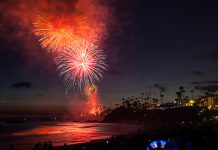An aviation first occurs just off Laguna’s coast
By Christopher J. Lynch | Special to the Independent
Photos courtesy of the Boeing Historical Society

George Franklin Smith never knew he would be flying into aviation’s history book that fateful day of Feb. 26, 1955. The Manhattan Beach resident and North American Aviation test pilot wasn’t even scheduled to work that Saturday. Called in to complete some overdue paperwork, he was asked before heading home for the day if he would perform the final checkout flight of a new F-100 Super Sabre jet so it could be delivered to the Air Force.
Never one to turn down an opportunity to fly, the 31-year-old Smith readily agreed and before long was barreling out of Los Angeles International Airport and into the gray winter sky.

His flight would take him along the Southern California coast to San Diego before circling back and
returning to Los Angeles. Part of the flight profile was to take the aircraft through the sound barrier.
He was at about 35,000 feet off the coast of Laguna Beach when he crossed the threshold of supersonic flight. It was at this point that things went very wrong.
The plane pitched nose down toward the Pacific Ocean at supersonic speed. Smith fought the controls relentlessly to re-level the plane, but it was a fruitless endeavor; he was heading straight down at over 777 mph!
With no options left and with only six seconds to impact, he did the unthinkable; he blew his canopy and ejected. No pilot in history had ever ejected at this speed and lived to tell about it!

The stresses effected on his body were like none any man had ever endured. He decelerated with a force that subjected his body to over 40Gs. His eyeballs nearly came out of his head, blood poured from his ears. His clothes, shoes and helmet were torn from his body. Once clear of the ejection seat, his body pin-wheeled and centrifuged so violently that his gloves, his wristwatch… even his ring were flung off!
He was rescued by a couple of men from Newport Beach who had been in the area fishing and ended up in Hoag Memorial Hospital where he lay unconscious for five days. When he finally came to, it wasn’t to the sound of doctors asking him questions or nurses checking his vitals; it was to the comforting words of the children of Aliso Elementary School in South Laguna.

When his airplane hit the water, it created a sonic boom which had rattled the windows of the school. A fifth grade teacher, Mrs. Pearl Phillipson, read of the pilot’s accident in the paper and assigned her class an assignment to write letters to him to be sent to the hospital. The children loved the assignment and over 30 letters found their way to Smith’s bedside where they were being read to him when he came to.
“I woke up on Thursday March 3,” he recalls, “to the sound of someone reading a bunch of children’s letters to me. I opened my eyes but I couldn’t see. I didn’t know where, what, why or anything for awhile, but the sound of those letters was pretty comforting as I began to realize what they were about.”
George Smith left the hospital three months later and continued to live a full life, eventually becoming a project manager for an aerospace firm. His accident resulted in the development of better ejection seats, helmets, and of the self-inflating life vest. He also contributed to the safety of future pilots in less tangible ways. He proved that a pilot could experience a supersonic bailout and live to tell about it. Because of this, pilots could now eject with more confidence and not try to pull it out and “auger in.”
George Smith died of natural causes at the age of 75 on May 1, 1999, in Orange County.

Christopher J. Lynch is a writer and mountaineer living in Los Angeles. He recently led a group of blind hikers to the summit of 10,000 ft. Mt. Baldy. A documentary film is being made of the adventure. www.baldyfortheblind.com





I remember that day, The “boom” was really loud and it cracked the auditorium wall at Aliso Elementary where I was a 3rd grader.